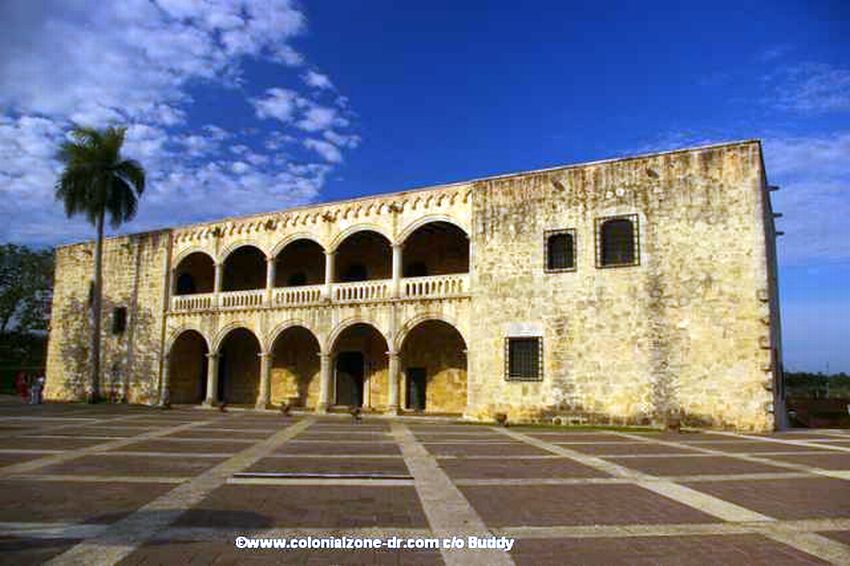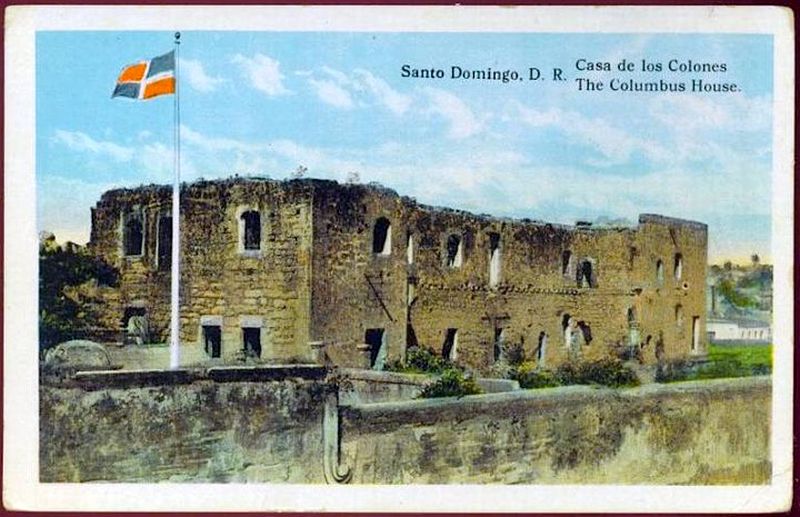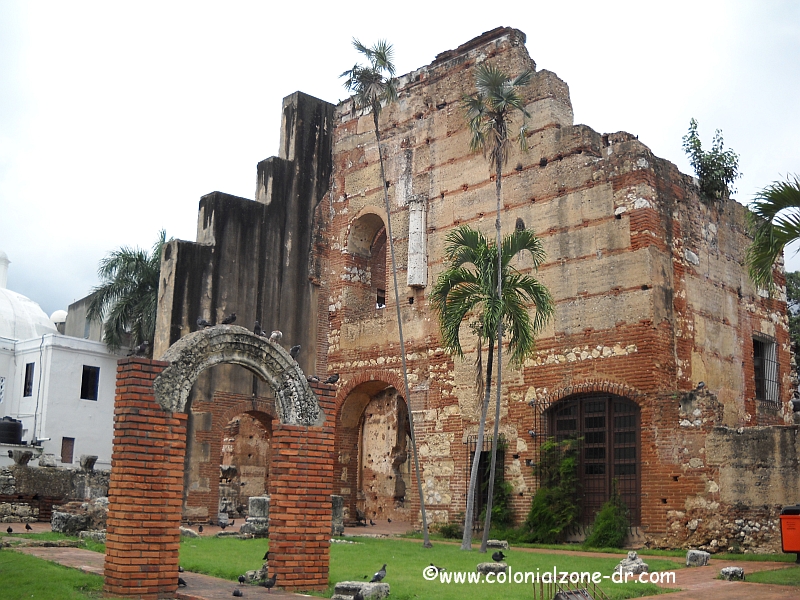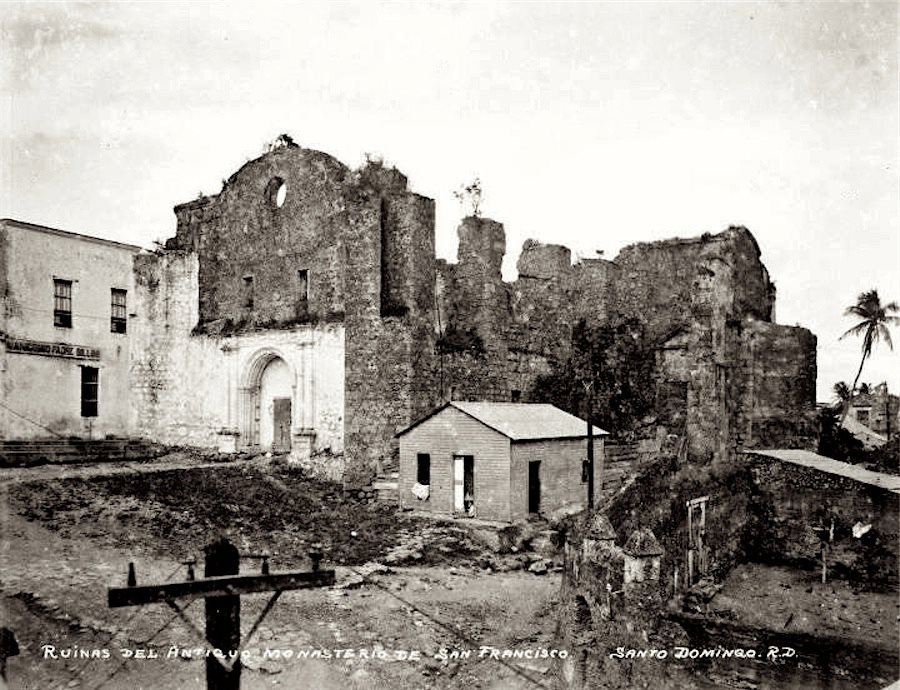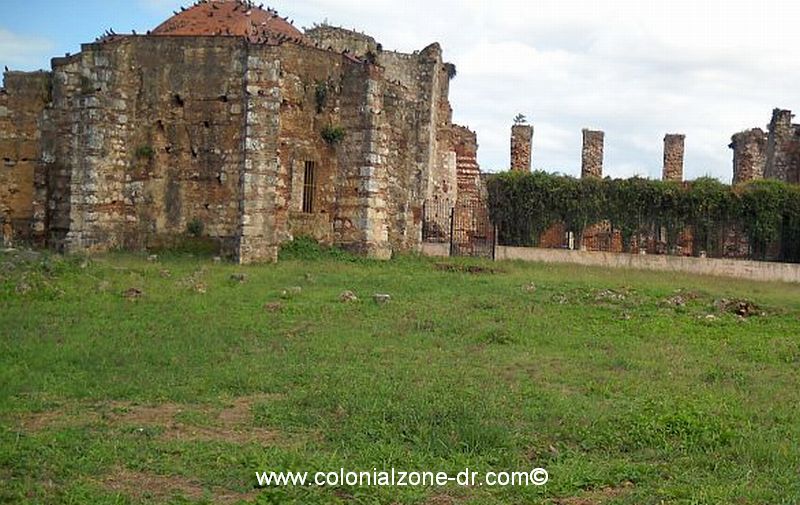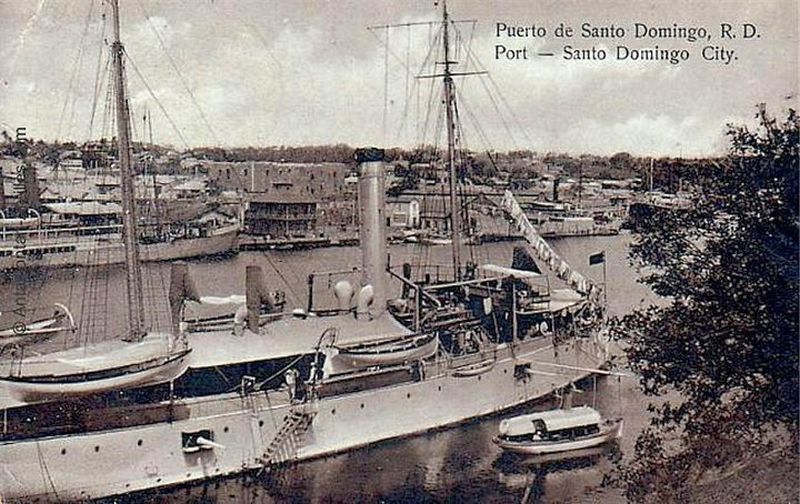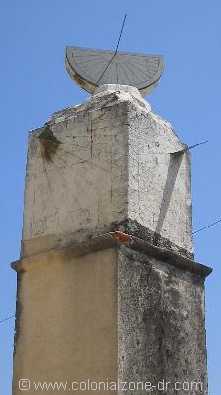Sun Dial/ Reloj de Sol This sun dial, erected during the reign of Carlos III in 1753, is one of the oldest sun dials in all the Americas. It was used as the official time-teller in Santo Domingo. The face of the dial could be seen from the government offices in the Casas Reales. This way the government officials were able to record the correct time on official documents.
The dial sits atop a large stone pillar and has two vertical dials or faces and a equatorial dial on top. The Southeast face is for the morning time to be seen and the Southwest side is for the afternoon hours. The large metal plate with its raised parts show the hours by the shaded markings. See the sun dial in the picture of Casa de Reales above.
On the very top of the pillar is the newer equatorial dial that was placed there in 1992. The original dial was lost during a hurricane.
Directions: Calle Las Damas in the small Plaza Reloj de Sol. see the map (number 38)
Palacio Virreinal Alcázar de Colón/ Columbus Palace is a 22 room stone home built by Columbus son Don Diego Colón and his wife. (Colon is the Spanish word for Columbus). They resided in this 50 room Viceregal palace with gardens balconies and courtyards during Diegos term as viceroy. This fortress was built during the early 1500s to be the seat of the viceroy court. Diego and his wife Maria de Toledo lived here until 1523 when he was recalled to Spain. Other relatives lived here for decades afterwards. This building was abandoned in 1770 and turned into a garbage dump. Cave-ins in 1809 and 1835 left the building in ruins.
It was restored by highly skilled stone cutters with added refinements made during several later restorations and the size is much smaller than the original building. All rebuilding was done to remain as faithful as possible to the original construction and decor. Not one single nail was used in it's construction. It opened to the public on Columbus Day in 1957.
The palace sits in a large open square, Plaza de Armas or Plaza de España, Always some activity happening here. A nice place to be. The plaza looks beautiful at night with the lights on. It now houses an extensive collection of furniture and household items from this period.
Direction: Calle Las Damas at Plaza España. Walking west on Calle el Conde go to the end, turn left and continue walking about 1 1/2 blocks straight ahead. You cannot miss it. see the map (number 30)
Las Casas Reales/ The Royal Houses
These two adjacent and connecting buildings were constructed at the same time between 1503 and 1520. The building on the right is the Palace of the Governor. The other building held the seat of the Royal Court/ Palace of Royal Audiences on the second floor and the ground floor held the General Accountancy.
The arched gothic style windows on the second floor where the Royal Court was held gave a perfect view of the Sun Dial so they always knew what time it was. Before the Royal Houses were built the Royal Court would meet in the City Hall building. This is where the jail was located, across from the Plaza de Armas. They held their sessions in one of the halls of the Atarazanas.
Alcazar de Colón/ Columbus Palace | Las Atarazanas/ The Atarazanas | Las Casa Reales/ The Royal Houses | Reloj de Sol/ Sun Dial | Ruinas (ruins) El Hospital San Nicolás de Bari | Ruinas (ruins) del Monasterio de San Francisco and Capilla de la Tercera Orden Franciscana / Chapel of the Franciscan Third Order |
Ruinas El Hospital San Nicolás de Bari/ Ruins and Hospital San Nicolas de Bari
The hospital was originally on the east of the Ozama river, built in November 1503. It is said that the hospital was built atop the home of a black woman who nursed the sick.
When the city moved to the opposite side of the river the hospital soon followed. Built by order of the governor Nicolas de Ovando because there was such a great need as sickness and disease was prevalent due to the heat, insects and lack of medicines and treatment knowledge. The hospital and doctors center with an adjoining church was funded entirely by contributions from the more affluent people of the colony.
The original building was a palm hut where the ladies who had the desire would come and take care of the sick as a charity offering. This palm building was only able to hold about six patients. The stone building replaced the palm one in 1519. Construction of this state of the art hospital made of stone and brick was complete in 1527. Only a small chapel remains of the second building.
Sitting atop a hill, looming, surrounded by an iron fence sits almost 2 blocks of buildings in ruins. It is a very humbling sight to behold. Looking majestic and eerie. It's menacing, eerie feeling is multiplied when you walk close and see the holes in the land surrounding the building. Some say that these were to hold prisoners. While others say they are places where excavations were done. There is also a deep well on site covered by a grate. In the past the inhabitants were lunatics and friars, now the sole inhabitants of the building are the pigeons and ghosts. The cooing of the birds, or maybe it be the moaning from the people of the past, add to the eerie feel of the place. In the evening the ruins seem to heighten in magnitude and mysteriousness. The lights shining on these abandoned and falling stone walls give it an immense forlorn and desolate feeling. Make sure when you visit you sit on the steps and take in the feeling of the place. If only these lonely bricks could tell their story.
The most important ruins of the Americas held the first monastery in the Americas. The building was started by Nicolás de Ovando in 1509 and was completed in 1560. Built on a hill overlooking the city it was, and is, a true marvel. It was divided into three parts, the Convento/ Convent, the Chapels (Capilla de la Tercera Orden de los Franciscano, the Capilla de Garay also known as the Chapel of Maria de Toledo, Diego Colons' wife), and San Francisco el viejo.
Over the largest part of the monasteries doorway is the Cordón de la Orden Franciscana, the coat of arms of the order, carved into the stone surrounding the arched doorway. There is a cross and a bust of Padre Billini. It was built on the outside in Renaissance style and the inside in Gothic.

See the entire Casa del Reales picture collection

Home | Dining & Night Life | Hotel | Sights | Pictures | Music | Colonial Zone Map | Hot Spots! Directory | Site Search




MENU
IN COLONIAL ZONE
THINGS DOMINICAN
If you found my web site useful please consider making a donation through Pay Pal . Thanks!

Our complete exchange rate tool.
Gracias a coinmill.com
|
|

site map Copyright © 2005 - 2016 All Rights Reserved. Colonial Zone-Dominican Republic (DR)
Home | Calendar | Night Life/Dining | Sight Seeing | Pictures | Businesses | Artists | Food | Helps | History | Language | Music | Media | Pastimes | Products | Tradition/Legend | Links | About Us | Buy Mamajuana | News Blog | DR Gringa's Life Blog | Dominican Dog Blog

Custom Search
+click to enlarge
(above) Alcazar Colon 2000
(below) Alcazar de Colon 1910
+click to enlarge
Casa Reales and the Reloj de Sol
There are Isabelic decorations, white porcelain bricks and many outer beautiful architectural styles to be seen in this powerful building. The huge ground floor windows make this building always have a cool breeze flowing through its luxurious stone and coral wall. Sometimes you can see the peacocks strutting around the large beautiful interior courtyard.
There is a replica of a colonial court room and many exhibits in the museum including the coat of arms of Spain. There is a beautiful staircase where underneath is a large globe of the world with a horse on his hind lags ready to jump over it. Here is written in Latin: Non sufficit orbis (The world is not large enough). more information on the museum
Directions: Calle las Damas and the beginning or Mercedes up from Plaza España. see the map (number 32)
+click to enlarge
Ruins San Nicolas de Bari
The third hospital was built from 1533 to 1556. It was much larger and could hold about fifty patients. This building took a beating from the Pirate Francis Drake in 1586 when he burned and destroyed the medical center and stole its contents including documents and many treasures of the church.
This building also served as a military hospital but continued to disintegrate due to hurricanes and earthquakes. Even though the building was in ill repair it continued to be used. Finally after the Restoration the hospital was abandoned to its decay. The walls were further destroyed when the chapel, the Nuestra Señora de la Altagracia, adjoining the decaying hospital was rebuilt in the 1930's. Then some walls were knocked down because they were in danger of falling.
One can still see the cross shaped outline of the ruins with the blue floor tile. There is a large amount of beggars in this area probably because of the Our Lady of Altagracia church .
Directions: Calle Hostos between Mercedes and Calle Luperón see the map (number 13)
Ruinas del Monasterio de San Francisco
+click to enlarge
(above) Ruinas de San Francisco
(below) Ruinas in the 1930´s
At one time this place was used as a military fort and named La Casa del Diablo/ The house of the Devil. It has also been called El basurero del Monasterio/ The Garbage Can of the Monastery. In 1881, Francisco Billini changed the building into a lunatic asylum. If you look on the inside there are still remnants of chains bolted to the walls where they tied the crazies
It was taken by the Pirate Francis Drake (for more information on Drake) during his very destructive raids on the city in 1586. Nature also attacked the monastery with two devastating earthquakes in 1673 and 1751.
It is also said to be where Bartholomew Columbus is buried, but this is not certain.
At times there are special events held here. There may be a concert or school group doing something. It is a favorite spot for taking wedding pictures. On Sundays the area is packed full with people all gathering with friends and family to see a free concert.
Directions: Calle Hostos, Restauracion, Duarte and Juan Isidro Perez (it takes up almost 2 city blocks) see the map (number 17)
Las Atarazanas/ The Atarazanas Translation - Spanish naval yard or warehouse
The Atarazanas on the Ozama River were warehouses used to store cargo brought in by the ships. This was the shipyards built in front of the Palace so the governor could keep a close eye on what was coming in and out of the country. The Atarazanas of Santo Domingo are the oldest in the Las Americas and they are the only buildings of their type that have survived.
Constructed between 1509 and 1536, when the roof was completed.The Atarazanas have remained in tact through all attacks and earthquakes (like the Cathedral) they have remained almost intact.
All the buildings surrounding the Plaza were at one time warehouses and shipyards. The Rio Ozama at one time came right up to the walls. Now these buildings surrounding Plaza España house many bars and restaurants.
+click to enlarge
(above) Plaza España Atarazanas 2000
(below) Shipyards Palace in distance early 1900´s
This chapels beautiful front is located in the Ruins of the Monasterio de San Francisco. It was part of the many phases of building within the walls of the monastery. It was built to join with the Capilla de Garay and the Capilla María de Toledo. All that remains today is the front of the chapel and the interior arches with a small remnant of the beautiful vaulted roof that was destroyed in a hurricane is 1930.
Location: From Calle el Conde turn north on Hostos. Go up the hill about 5 blocks. It is facing E. Tejera near to a little park. See the map (number 16)
Capilla de la Tercera Orden Franciscana / Chapel of the Franciscan Third Order
+click to enlarge
Remnants of the vaulted roof inside.
+click to enlarge
Reloj de Sol

